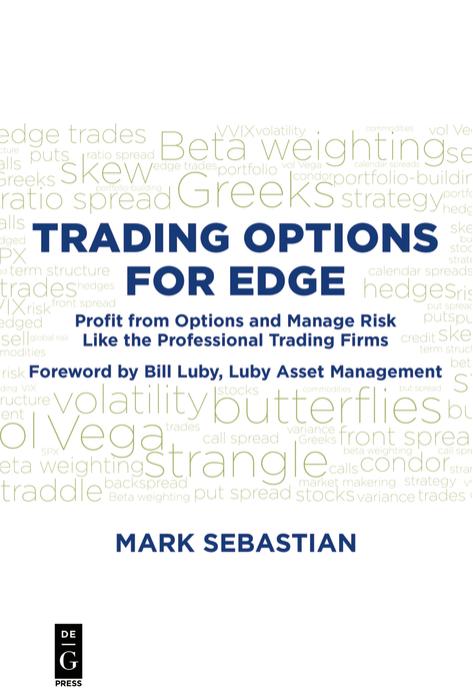Trading Options for Edge by Mark Sebastian

Author:Mark Sebastian
Language: eng
Format: epub, pdf
Publisher: De Gruyter
The Strangle
A strangle, long or short, is a straddle with split strikes. The strangle takes in less premium; in return, you get a wider landing pad for the underlying to move about. Like a straddle, a strangle is vega- and gamma-centric. The strangle wants perception of movement to change and movement to change. The long strangle looks for movement and perception of movement to increase. In the example in Figure 7.9, you buy the May 2250 put and 2375 call at the same time.
Figure 7.9: A long strangle in the SPX. You look for movement or an increase in belief that there will be movement. You want something to happen. Wrapping up a long strangle the basic structure is:
–The spread does not have a preference in direction of the underlying, thus it is flat delta. The spread needs something to happen, thus it is long gamma. If nothing happens, the spread will lose money as time passes, thus it is short theta. The spread is buying premium; thus it wants belief that movement will increase, making it long vega.
Looking at a short straddle Figure 7.10, you are trading off a lot of risk for your belief that the underlying isn’t going to move. If the underlying moves, you will lose, if the perception is that the underlying is going to move, you will lose. You are set up with a wider landing pad than a straddle, but you receive fewer dollars than a straight straddle. You receive fewer dollars (theta) relative to the straddle, but in return, the points where you lose money are much wider than a straddle.
Figure 7.10: A short straddle in SPX. You need the underlying not do something; in this case, move outside of the strikes you sold. Based on the P&L, you need the underlying to sit and the perception of movement to sit. Strangles are essentially straddles with more room whether bought or sold. Personally, I do not like buying or selling these. I think the risk-reward does not work for the independent trader. I feel similarly about straddles, but will trade them from time to time, because they are a stronger play on a hard belief. Wrapping up a short strangle, the basic structure is:
–The spread at onset does not have a preference in direction of the underlying, thus it is flat delta. The spread wants nothing to happen, thus it is short gamma. If nothing happens the spread will make money as time passes, thus it is long theta. The spread is selling premium; thus it wants belief that movement will decrease, making it short vega.
Download
This site does not store any files on its server. We only index and link to content provided by other sites. Please contact the content providers to delete copyright contents if any and email us, we'll remove relevant links or contents immediately.
| Private Equity | Valuation |
| Venture Capital |
The Black Swan by Nassim Nicholas Taleb(6183)
Bad Blood by John Carreyrou(5761)
Pioneering Portfolio Management by David F. Swensen(5599)
Millionaire: The Philanderer, Gambler, and Duelist Who Invented Modern Finance by Janet Gleeson(3565)
Skin in the Game by Nassim Nicholas Taleb(3455)
The Money Culture by Michael Lewis(3276)
Skin in the Game: Hidden Asymmetries in Daily Life by Nassim Nicholas Taleb(3259)
Bullshit Jobs by David Graeber(3172)
The Wisdom of Finance by Mihir Desai(3069)
Blockchain Basics by Daniel Drescher(2883)
Liar's Poker by Michael Lewis(2805)
The Intelligent Investor by Benjamin Graham Jason Zweig(2594)
Mastering Bitcoin: Programming the Open Blockchain by Andreas M. Antonopoulos(2504)
Hands-On Machine Learning for Algorithmic Trading by Stefan Jansen(2489)
Investing For Dummies by Eric Tyson(2467)
Fooled by Randomness: The Hidden Role of Chance in Life and in the Markets by Nassim Nicholas Taleb(2407)
The Power of Broke by Daymond John(2373)
Zero Hour by Harry S. Dent Jr. & Andrew Pancholi(2240)
Market Wizards by Jack D. Schwager(2155)
